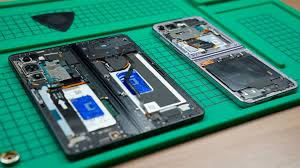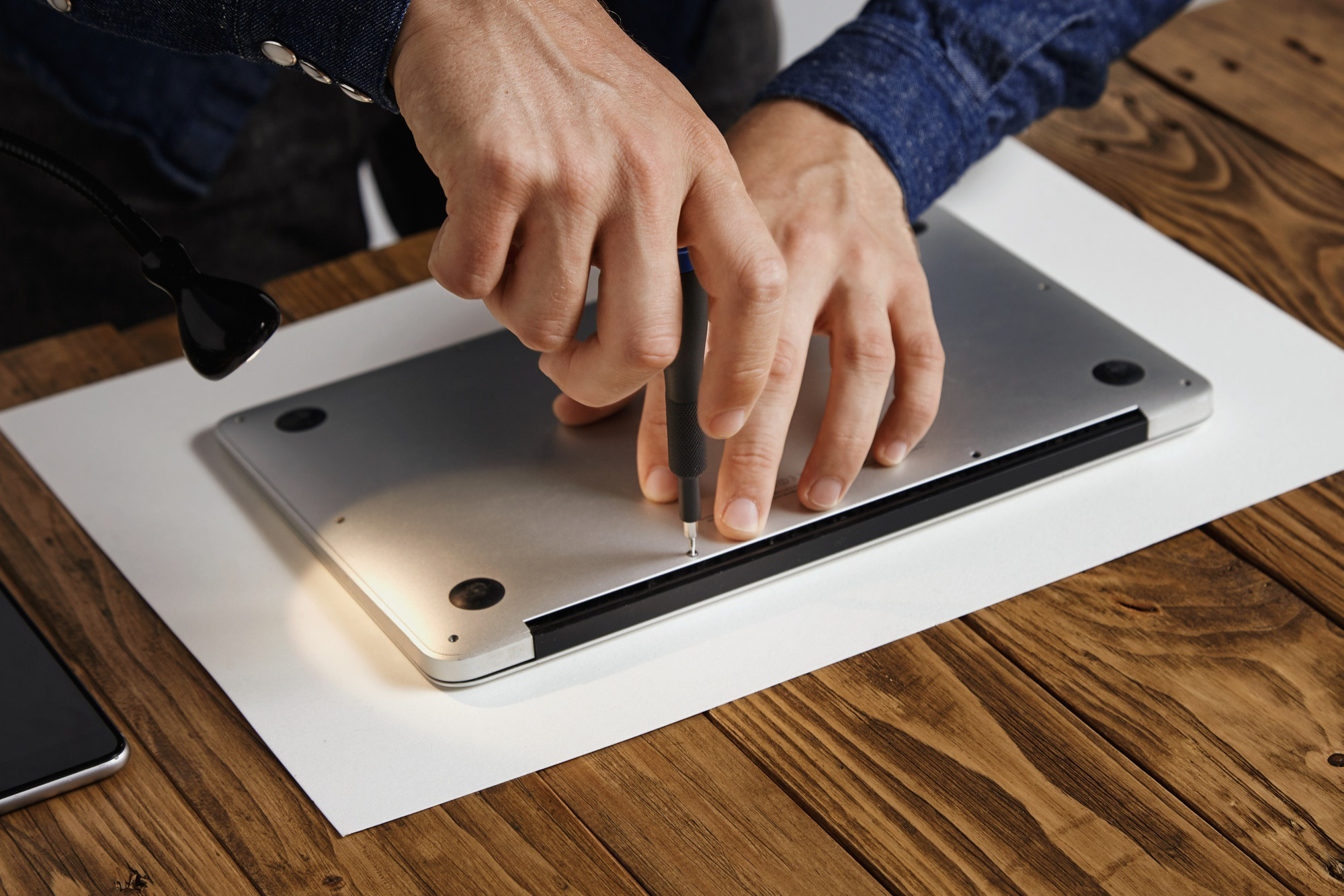11/02/2024 01:52:46 PM / GETTING STARTED
Laptop Broken Screen Repair: What You Need to Know
A laptop is an essential tool for many of us, whether for work, school, or entertainment. One of the most frustrating issues that can arise is a broken screen. If you’ve found yourself in this situation, you’re not alone. In this blog post, we’ll explore the common causes of broken laptop screens, the repair process, and tips for preventing damage in the future.
Common Causes of Laptop Screen Damage
Laptop screens can break for a variety of reasons, including:
-
Accidental Drops: One of the most common causes of a broken screen is a drop or fall. Whether it slips from your hands or is knocked off a table, impact can lead to cracks or shatters.
-
Pressure Damage: Sitting on a laptop or placing heavy items on top of it can cause pressure damage. Even closing the laptop too forcefully can lead to screen issues.
-
Liquid Spills: Accidental spills are another frequent culprit. Liquid can seep into the screen or the internal components, causing damage that may not be immediately visible.
-
Wear and Tear: Over time, components can wear down. Regular use, including opening and closing the laptop, can contribute to screen issues, especially if the hinges are compromised.
The Repair Process
When it comes to repairing a broken laptop screen, it’s essential to understand the steps involved. Here’s a general overview:
-
Diagnosis: The first step is a thorough examination of the laptop. A technician will check the screen for cracks, flickering, or other issues. They will also inspect the internal components to determine if there’s any damage beyond the screen itself.
-
Disassembly: If the screen needs replacement, the technician will carefully disassemble the laptop. This process involves removing the battery, keyboard, and other components to access the screen.
-
Replacement: Once the laptop is disassembled, the broken screen is removed and replaced with a new one. It’s crucial to ensure that the replacement screen is compatible with the specific laptop model.
-
Reassembly: After the new screen is installed, the technician will reassemble the laptop, ensuring all components are properly secured.
-
Testing: Before returning the laptop to the owner, the technician will test the new screen to ensure it’s functioning correctly and that there are no other issues.
DIY vs. Professional Repair
While some may consider attempting a DIY repair, it’s generally advisable to seek professional help. Repairing a laptop screen requires specialized tools and expertise. Incorrect handling can lead to further damage, potentially resulting in a more costly repair. Moreover, many warranties are voided if unauthorized repairs are performed.
Tips for Preventing Screen Damage
Prevention is always better than cure. Here are some tips to help you protect your laptop screen:
-
Use a Protective Case: Invest in a sturdy laptop case or sleeve to protect it during transport.
-
Avoid Placing Heavy Items on the Laptop: Be mindful of what you place on top of your laptop when it’s closed.
-
Keep Liquids Away: Be cautious when consuming beverages near your laptop, and consider using spill-resistant containers.
-
Handle with Care: Always handle your laptop gently, avoiding sudden movements and drops.
Conclusion
A broken laptop screen can be a significant inconvenience, but with the right knowledge and help, you can get your device back in working order. If you find yourself in need of laptop screen repair, don’t hesitate to contact our experienced technicians. We’re here to provide quality repairs and ensure your laptop is running smoothly again!
A laptop is an essential tool for many of us, whether for work, school, or entertainment. One of the most frustrating issues that can arise is a broken screen. If you’ve found yourself in this situation, you’re not alone. In this blog post, we’ll explore the common causes of broken laptop screens, the repair process, and tips for preventing damage in the future.
Common Causes of Laptop Screen Damage
Laptop screens can break for a variety of reasons, including:
-
Accidental Drops: One of the most common causes of a broken screen is a drop or fall. Whether it slips from your hands or is knocked off a table, impact can lead to cracks or shatters.
-
Pressure Damage: Sitting on a laptop or placing heavy items on top of it can cause pressure damage. Even closing the laptop too forcefully can lead to screen issues.
-
Liquid Spills: Accidental spills are another frequent culprit. Liquid can seep into the screen or the internal components, causing damage that may not be immediately visible.
-
Wear and Tear: Over time, components can wear down. Regular use, including opening and closing the laptop, can contribute to screen issues, especially if the hinges are compromised.
The Repair Process
When it comes to repairing a broken laptop screen, it’s essential to understand the steps involved. Here’s a general overview:
-
Diagnosis: The first step is a thorough examination of the laptop. A technician will check the screen for cracks, flickering, or other issues. They will also inspect the internal components to determine if there’s any damage beyond the screen itself.
-
Disassembly: If the screen needs replacement, the technician will carefully disassemble the laptop. This process involves removing the battery, keyboard, and other components to access the screen.
-
Replacement: Once the laptop is disassembled, the broken screen is removed and replaced with a new one. It’s crucial to ensure that the replacement screen is compatible with the specific laptop model.
-
Reassembly: After the new screen is installed, the technician will reassemble the laptop, ensuring all components are properly secured.
-
Testing: Before returning the laptop to the owner, the technician will test the new screen to ensure it’s functioning correctly and that there are no other issues.
DIY vs. Professional Repair
While some may consider attempting a DIY repair, it’s generally advisable to seek professional help. Repairing a laptop screen requires specialized tools and expertise. Incorrect handling can lead to further damage, potentially resulting in a more costly repair. Moreover, many warranties are voided if unauthorized repairs are performed.
Tips for Preventing Screen Damage
Prevention is always better than cure. Here are some tips to help you protect your laptop screen:
-
Use a Protective Case: Invest in a sturdy laptop case or sleeve to protect it during transport.
-
Avoid Placing Heavy Items on the Laptop: Be mindful of what you place on top of your laptop when it’s closed.
-
Keep Liquids Away: Be cautious when consuming beverages near your laptop, and consider using spill-resistant containers.
-
Handle with Care: Always handle your laptop gently, avoiding sudden movements and drops.
Conclusion
A broken laptop screen can be a significant inconvenience, but with the right knowledge and help, you can get your device back in working order. If you find yourself in need of laptop screen repair, don’t hesitate to contact our experienced technicians. We’re here to provide quality repairs and ensure your laptop is running smoothly again!
A laptop is an essential tool for many of us, whether for work, school, or entertainment. One of the most frustrating issues that can arise is a broken screen. If you’ve found yourself in this situation, you’re not alone. In this blog post, we’ll explore the common causes of broken laptop screens, the repair process, and tips for preventing damage in the future.
Common Causes of Laptop Screen Damage
Laptop screens can break for a variety of reasons, including:
Accidental Drops: One of the most common causes of a broken screen is a drop or fall. Whether it slips from your hands or is knocked off a table, impact can lead to cracks or shatters.
Pressure Damage: Sitting on a laptop or placing heavy items on top of it can cause pressure damage. Even closing the laptop too forcefully can lead to screen issues.
Liquid Spills: Accidental spills are another frequent culprit. Liquid can seep into the screen or the internal components, causing damage that may not be immediately visible.
Wear and Tear: Over time, components can wear down. Regular use, including opening and closing the laptop, can contribute to screen issues, especially if the hinges are compromised.
The Repair Process
When it comes to repairing a broken laptop screen, it’s essential to understand the steps involved. Here’s a general overview:
Diagnosis: The first step is a thorough examination of the laptop. A technician will check the screen for cracks, flickering, or other issues. They will also inspect the internal components to determine if there’s any damage beyond the screen itself.
Disassembly: If the screen needs replacement, the technician will carefully disassemble the laptop. This process involves removing the battery, keyboard, and other components to access the screen.
Replacement: Once the laptop is disassembled, the broken screen is removed and replaced with a new one. It’s crucial to ensure that the replacement screen is compatible with the specific laptop model.
Reassembly: After the new screen is installed, the technician will reassemble the laptop, ensuring all components are properly secured.
Testing: Before returning the laptop to the owner, the technician will test the new screen to ensure it’s functioning correctly and that there are no other issues.
DIY vs. Professional Repair
While some may consider attempting a DIY repair, it’s generally advisable to seek professional help. Repairing a laptop screen requires specialized tools and expertise. Incorrect handling can lead to further damage, potentially resulting in a more costly repair. Moreover, many warranties are voided if unauthorized repairs are performed.
Tips for Preventing Screen Damage
Prevention is always better than cure. Here are some tips to help you protect your laptop screen:
Use a Protective Case: Invest in a sturdy laptop case or sleeve to protect it during transport.
Avoid Placing Heavy Items on the Laptop: Be mindful of what you place on top of your laptop when it’s closed.
Keep Liquids Away: Be cautious when consuming beverages near your laptop, and consider using spill-resistant containers.
Handle with Care: Always handle your laptop gently, avoiding sudden movements and drops.
Conclusion
A broken laptop screen can be a significant inconvenience, but with the right knowledge and help, you can get your device back in working order. If you find yourself in need of laptop screen repair, don’t hesitate to contact our experienced technicians. We’re here to provide quality repairs and ensure your laptop is running smoothly again!



